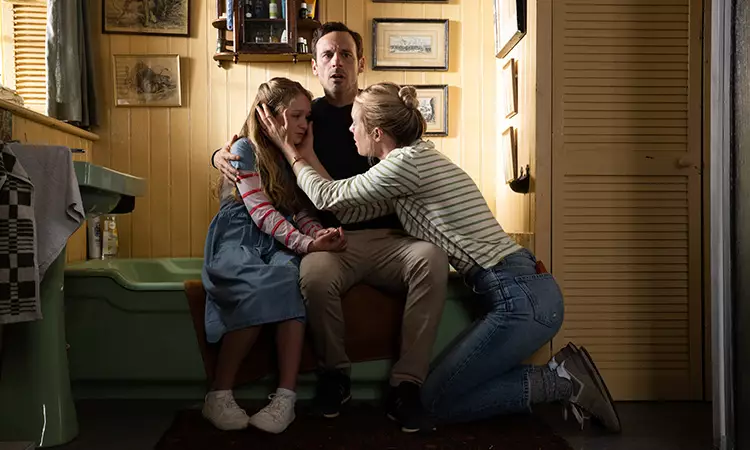In an era where horror is routinely laden with jump scares and hollow narratives, the film “Speak No Evil” dares to tread a different path. This psychological thriller, produced by the innovative team at Blumhouse, juxtaposes mundane social discomfort with the fringes of human morality. With an impressive cast led by Scoot McNairy and Mackenzie Davis, the film explores deeper themes that resonate intimately with today’s societal issues, reminding viewers that horror doesn’t always need to be overtly gruesome to be effective. Instead, it articulates an unsettling realism that creeps beneath the skin, offering a vivid portrayal of the nuances of human interactions.
A Premise Rich in Psychological Tension
At its core, “Speak No Evil” chronicles the experiences of the Dalton family—Ben, Louise, and their daughter Agnes—as they accept an invitation from a seemingly congenial British family. What starts as a delightful retreat quickly devolves into a labyrinth of psychological manipulation and discomfort. The film thrives on its unpredictability, expertly building tension through mundane interactions that evoke deep-seated fears and anxieties within ordinary social exchanges.
McNairy’s character, Ben, embodies the struggle of conformity in a world burdened by the expectations of social nicety. His reservations about the invitation hint at a profound internal conflict that resonates strongly with audiences. It raises questions about personal boundaries and the lengths individuals might go to adhere to societal norms, particularly when those norms conflict with personal ethics.
One of the film’s more provocative themes is its exploration of toxic masculinity through the character Paddy, expertly portrayed by James McAvoy. McNairy highlights this dynamic, illustrating how the character of Ben finds himself pitted against an ‘alpha male’ persona that embodies societal aggression and dominance. This narrative choice sheds light on modern masculinity’s pitfalls, revealing how easily complicated relationships can develop when vulnerability meets bravado.
A critical examination of the characters’ interactions reveals how social expectations create environments ripe for discomfort. The tension between the characters simmers subtly, reflecting real-life challenges faced by many individuals navigating male-dominated spaces—where sensitivity and strength are often at odds. The film encourages viewers to confront these issues head-on, inviting reflection on what true masculinity should embody in a contemporary context.
McNairy and Davis both elucidate that the motivations driving their characters’ actions stem from a desire to salvage their faltering marriage. The couple is introduced in a crisis, struggling with the strains of therapy and compromise. This backdrop serves not only to humanize their decisions—a source of frustration for viewers—but also enriches the narrative with emotional stakes that resonate beyond the conventional horror framework.
Davis articulates the challenge faced by her character, Louise, who grapples with complex emotions while attempting to maintain harmony in her marriage. This delicate balance aids in creating a more nuanced narrative, revealing how fear and discomfort can often stem from personal relationships rather than external threats. This intentional focus on relational dynamics elevates the movie beyond mere genre constraints, integrating real emotional stakes that heighten the film’s impact.
As the film enfolds, it grapples with the broader implications of modern fear—a lens through which contemporary audiences can examine their anxieties. The psychological horror explored in “Speak No Evil” serves as a reflection of the internalized fears fostered by social media and the pressures of contemporary life. The filmmakers artfully illuminate how modern society, with its myriad influences, shapes the way individual fears manifest, often leading down a precarious path of self-doubt and unrest.
Davis aptly notes that horror’s conventional structure allows for an insightful exploration of uncomfortable themes. By veiling profound societal issues within the guise of a thriller, “Speak No Evil” offers audiences a unique opportunity to engage with complex conversations in a manner that is simultaneously entertaining and thought-provoking.
“Speak No Evil” is not merely another entry in the horror genre; it is a complex exploration of human emotions and the psychological landscape of everyday interactions. The film adeptly challenges viewers to confront their discomfort, ultimately leading them to reflect on the societal structures that shape their fears. As audiences engage with this modern psychological thriller, they are encouraged to examine the underlying themes of empathy, masculinity, and the fragility of modern relationships—making “Speak No Evil” a poignant study in horror, far removed from conventional tropes. In a moving conclusion, McNairy’s hope for the film—to leave audiences “scared out of their minds”—highlights a crucial achievement: a fear unbound from the screen, resonating deeply within society.

